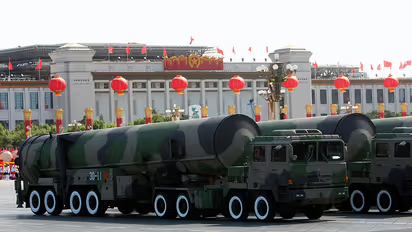China's nuclear arsenal grows from 500 to 600 warheads in a year, Pentagon warns of rapid expansion

Synopsis
The Pentagon, in its annual report to the US Congress, has raised concerns about China’s rapidly advancing military capabilities, highlighting significant strides in nuclear, naval, and air force modernization.
The Pentagon, in its annual report to the US Congress, has raised concerns about China’s rapidly advancing military capabilities, highlighting significant strides in nuclear, naval, and air force modernization. The report underscores Beijing's strategic efforts to bolster its defense infrastructure and extend its global military reach.
The report notes that China's operational nuclear warhead stockpile has surged from over 500 in 2023 to more than 600 in 2024. Projections suggest this arsenal could expand to 1,000 warheads by 2030. Leveraging intelligence and open-source data, the Pentagon asserts that this growth enables China to potentially target more US cities, military facilities, and leadership sites in a nuclear conflict.
China’s advancements include the development of intercontinental ballistic missiles (ICBMs) designed to enhance its nuclear strike capabilities, necessitating increased nuclear warhead production. Furthermore, Beijing has likely completed the construction of three new ICBM silo fields by 2022, accommodating at least 300 silos, some of which are already operational. The report also suggests that China may be exploring conventionally armed intercontinental-range missile systems capable of threatening U.S. territory.
Naval strength
China’s navy now boasts over 370 ships and submarines, up from approximately 340 in 2022, according to the report. The Pentagon highlights the growing capabilities of the Chinese navy, emphasizing its expanding ability to conduct missions beyond the "first island chain," which includes regions such as Japan’s Okinawa, Taiwan, and the Philippines. This maritime expansion underscores Beijing’s intent to assert its presence in critical strategic waters.
Air Force Modernization
The report reveals that the People’s Liberation Army Air Force (PLAAF) is nearing technological parity with the US air force. The PLAAF is actively modernizing its fleet, integrating indigenous technologies, and enhancing its unmanned aerial systems, further narrowing the technological gap between the two nations.
Global Military Reach
The Pentagon also highlights China’s ambitions to extend its military presence globally. Beyond its established base in Djibouti, Beijing is reportedly exploring the establishment of military logistics facilities in countries such as Myanmar, Pakistan, Bangladesh, Kenya, and Nigeria. Such infrastructure could disrupt US operations and strengthen China’s ability to project power over greater distances.
Increased Pressure on Taiwan
The report points to heightened Chinese pressure on Taiwan, encompassing diplomatic, political, and military domains. In 2023, China amplified its efforts to undermine longstanding norms in the Taiwan Strait, employing various tactics to exert influence. Taiwan’s Ministry of National Defense recorded a notable increase in Chinese aircraft crossing the Taiwan Strait centerline during the year.
The Pentagon’s report paints a stark picture of China’s military trajectory, emphasizing the need for vigilance and strategic planning. With its growing arsenal and expanding influence, Beijing’s actions could reshape regional and global security dynamics, posing significant challenges to US interests and its allies.
Check the Breaking News Today and Latest News from across India and around the world. Stay updated with the latest World News and global developments from politics to economy and current affairs. Get in-depth coverage of China News, Europe News, Pakistan News, and South Asia News, along with top headlines from the UK and US. Follow expert analysis, international trends, and breaking updates from around the globe. Download the Asianet News Official App from the Android Play Store and iPhone App Store for accurate and timely news updates anytime, anywhere.